Plate with Lion Motif
Plate with Lion Motif
4th-5th Century, Sasanian, Iran
Silver-Plated Bronze
Diam.: 18 cm
£28,000
A plate of silver gilt bronze, incised with a large image of a roaring lion. The lion is depicted mid-stride, with its foreleg raised in front of it. The lion’s mouth is opened wide, displaying its long, pointed teeth and protruding tongue. The snarl animates the rest of the facial features too, with thick wrinkles behind the nose and around the widened eyes. The texture of the mane is suggested through rows of parallel lines in waves around the front of the chest, and tighter curls down the back of the neck. The fur is also evoked on the underbelly and hackles. The long slender tail of the lion curves up behind it, and ends with a trefoil palmette. The tripartite paws, with their sharp elongated claws, stand on simple curved lines suggesting a rocky terrain. Waves fill the base of the design, with a small fish in the bottom right.
The Sasanian Dynasty (224-651 A.D.) was the last Iranian Empire before the rise of Islam, and was one of the world’s leading powers of this period, alongside the Byzantine Empire. The empire stretched west to the Mediterranean, east to present-day Afghanistan, and north into parts of Uzbekistan. Silver vessels of the Sasanian type have been found across these areas, possibly exported from Persia, but potentially also made there by locals influenced by their Sasanian rulers. In fact, few of the objects known today were found in what is now Iran and Iraq; the majority were found in Perm, west of the Ural Mountains. Plates and bowls make up the majority of Sasanian silver finds, particularly plates with a simple, low ring foot. These largely feature decoration on the inside surface, as in this example.
With Nicolas Koutoulakis (1910-1996), Geneva, by at least 1963.
Private Collection of Nicole and Jean-Michel Thierry de Crussol (1916-2011), Étampes, France, acquired from the above, accompanied by inventory notes.
ALR: S00258877, with IADAA Certificate, this item has been checked against the Interpol database.
Nicolas Koutoulakis (1910-1996) was a Paris- and Geneva-based antiquities dealer who ran Gallery Segredakis. He sold and donated a number of antiquities to cultural institutions around the world, including the British Museum, J. Paul Getty Museum, the Metropolitan Museum of Art, and the Museum of Fine Art, Boston.
Jean-Michel Thierry de Crussol (1916-2011) was born in Bagnères de Luchon, France, on 13 August 1916. After studying in Paris, he went on to become both a physician and art historian, who specialised in Byzantine and Armenian art. He worked alongside his wife, Nicole, at the hospital in Étampes: Jean-Michel as a surgeon, and Nicole as an anaesthesiologist. They were united both by their career and their shared love of culture, history, and art. They were particularly interested in Greek and Byzantine art, and repeatedly travelled to Cappadocia, where they discovered Byzantine churches and their paintings. These interests led Jean-Michel to Armenian art and architecture. Through more than thirty trips carried out between 1964 and 2011, the couple built up a highly complete and sought-after photographic archive of Armenian architecture. They gave presentations to the Armenian communities back in France, and by the 1980s had begun travelling occasionally with the architect Dupin, who would draw up plans of the churches they were photographing. Alongside Patrick Donabedian, the couple co-wrote the book Armenian Art in 1989, and also published many articles on the subject. Jean-Michel also taught Armenian Culture at the Institut National des Langues et Civilisations Orientales in Paris.










 Enquire
Enquire




